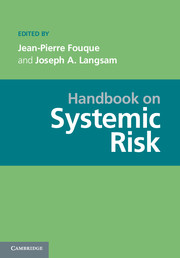Book contents
- Frontmatter
- Contents
- Contributors
- Introduction
- PART I DATA: THE PREREQUISITE FOR MANAGING SYSTEMIC RISK
- PART II STATISTICS AND SYSTEMIC RISK
- PART III MEASURING AND REGULATING SYSTEMIC RISK
- PART IV NETWORKS
- PART V SYSTEMIC RISK ANDMATHEMATICAL FINANCE
- 14 Firms, Banks and Households
- 15 An Agent-Based Computational Model for Bank Formation and Interbank Networks
- 16 Diversification in Financial Networks may Increase Systemic Risk
- 17 Systemic Risk Illustrated
- 18 Financial Crisis and Contagion: A Dynamical Systems Approach
- PART VI COUNTERPARTY RISK AND SYSTEMIC RISK
- PART VII ALGORITHMIC TRADING
- PART VIII BEHAVIORAL FINANCE: THE PSYCHOLOGICAL DIMENSION OF SYSTEMIC RISK
- PART IX REGULATION
- PART X COMPUTATIONAL ISSUES AND REQUIREMENTS
- PART XI ACCOUNTING ISSUES
- References
16 - Diversification in Financial Networks may Increase Systemic Risk
from PART V - SYSTEMIC RISK ANDMATHEMATICAL FINANCE
Published online by Cambridge University Press: 05 June 2013
- Frontmatter
- Contents
- Contributors
- Introduction
- PART I DATA: THE PREREQUISITE FOR MANAGING SYSTEMIC RISK
- PART II STATISTICS AND SYSTEMIC RISK
- PART III MEASURING AND REGULATING SYSTEMIC RISK
- PART IV NETWORKS
- PART V SYSTEMIC RISK ANDMATHEMATICAL FINANCE
- 14 Firms, Banks and Households
- 15 An Agent-Based Computational Model for Bank Formation and Interbank Networks
- 16 Diversification in Financial Networks may Increase Systemic Risk
- 17 Systemic Risk Illustrated
- 18 Financial Crisis and Contagion: A Dynamical Systems Approach
- PART VI COUNTERPARTY RISK AND SYSTEMIC RISK
- PART VII ALGORITHMIC TRADING
- PART VIII BEHAVIORAL FINANCE: THE PSYCHOLOGICAL DIMENSION OF SYSTEMIC RISK
- PART IX REGULATION
- PART X COMPUTATIONAL ISSUES AND REQUIREMENTS
- PART XI ACCOUNTING ISSUES
- References
Summary
Abstract It has been pointed out in the macroeconomics and financial risk literature that risk-sharing by diversification in a financial network may increase the systemic risk. This means roughly that while individual agents in the network, for example banks, perceive their risk of default or insolvency decrease as a result of cooperation, the overall risk, that is, the risk that several agents may default simultaneously, or nearly so, may in fact increase. We present the results of a recent mathematical study that addresses this issue, relying on a mean-field model of interacting diffusions and its large deviations behavior. We also review briefly some recent literature that addresses similar issues.
Keywords systemic risk, mean field, large deviations, dynamic phase transitions; MSC Codes: 60F10, 60K35, 91B30, 82C26
Introduction
Systemic risk is the risk that a large number of components of an interconnected financial system fail within a short time thus leading to the overall failure of the financial system. What is particularly interesting is that the onset of this overall failure can occur even when the individual agents in the system perceive that their own individual risk of failure is diminished by diversification through cooperation. This phenomenon is described and put into a broader perspective in Haldane's recent presentation (Haldane, 2009), which was the starting point of our own work (Garnier et al., 2012). In this review we first introduce and describe our model for the role of cooperation in determining systemic risk.
- Type
- Chapter
- Information
- Handbook on Systemic Risk , pp. 432 - 443Publisher: Cambridge University PressPrint publication year: 2013
References
- 14
- Cited by

